You can disable Wakeup Password in Windows 11 for Sleep, Modern Standby, and Hibernate states and stop Windows 11 from asking you for sign-in on wakeup. There are plenty of methods you can use to change this behavior. In this post, we will reviewed them all.
Advertisеment
By default, Windows 11 asks you to enter your password to sign-in and wakeup from Sleep, Hibernate, and other power states. This behavior helps to secure your device and your user account. It makes sure that if someone else turns on your "sleeping" laptop or computer, he won't access your sensitive data.
If you are the only person who use your PC and it never leaves your home, you may want to disable the password and sign-in requirement for sleep states on Windows 11. Here's how.
How to Disable Password on Wakeup in Windows 11
We will review a number of methods to disable the password on wakeup in Windows 11. First of all, you can use the Settings app. In certain situations, you may prefer to change it from a command prompt or script. Finally, there are options in Group Policy and in the Registry. Let's learn the methods to see what works best in your situation.
Disable Wakeup Password in Windows 11 Settings
- Open the Settings app using the Win + I keyboard shortcut.
- Click on Accounts in the left pane.
- On the right, click on Sign-in options.
- For the If you've been away, when should Windows require you to sign in again? drop-down option, select Never.
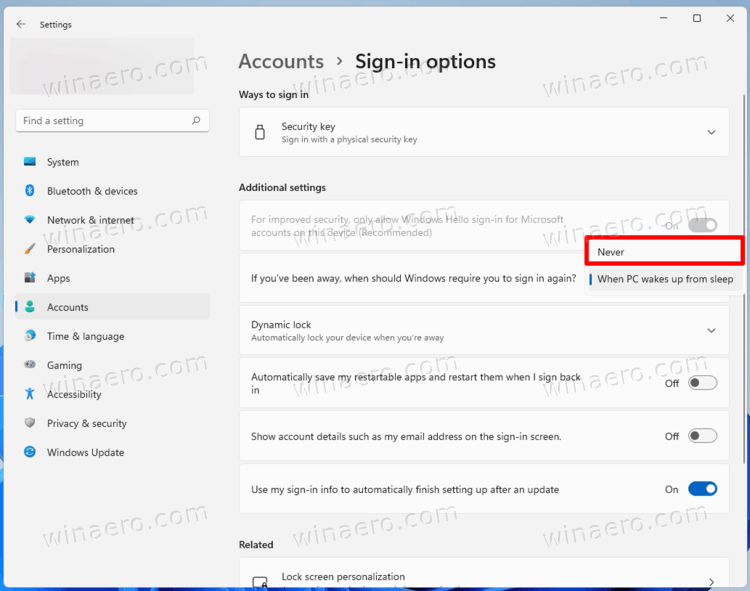
- You can now close the Settings app.
The drop-down menu for this option may include different values. If your device supports Modern Standby, you can set the wake up option to Every Time, 1 minute, 3 minutes, 5 minutes, or 15 minutes. The default option is Every Time, that means that you have to enter your password every time you wake up your device. It is important to note that this option has effect for the current user only.
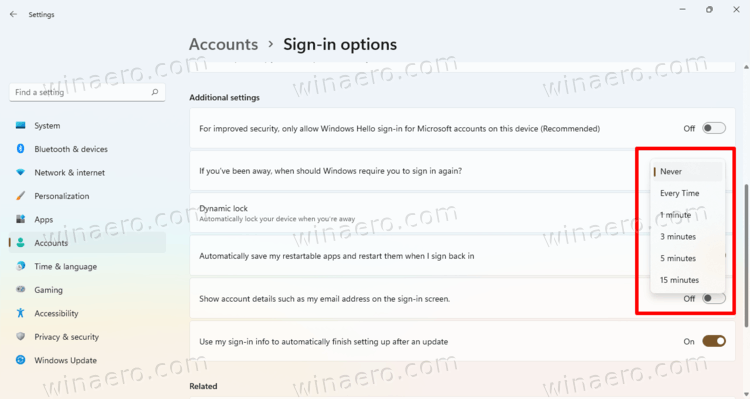
However, if the Modern Standby option is not supported, the only options to choose from are Never and When PC wakes up from sleep. The latter is the default value. Windows 11 uses these options to specify how it should return from Sleep or Hibernate. By changing this option in Setting, you will modify the current Power Plan settings. The change will affect all user accounts.
Check if your Windows 11 device supports Modern Standby
Open a new Windows Terminal as Administrator, and type and run the powercfg -a command.
If then command output, see the value for Standby (S0 Low Power Idle) Network Connected or Standby (S0 Low Power Idle) Network Disconnected lines. If one one them says "Available", then your device supports Modern Standby. Mine doesn't support it:
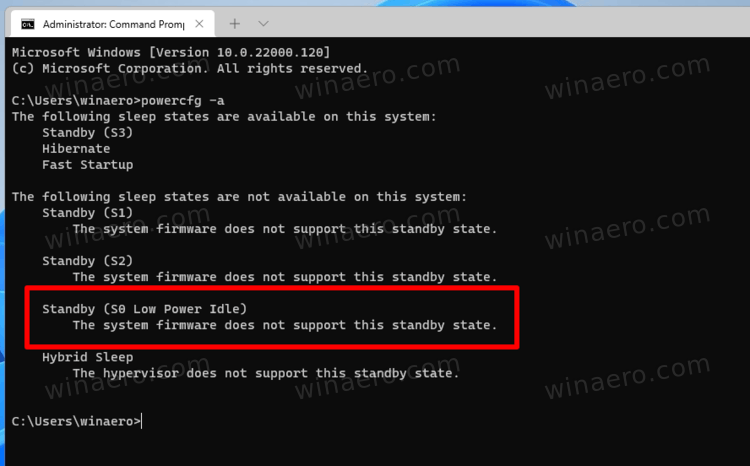
Alternatively, you can change disable the wakeup password request in Windows 11 using the powercfg tool. This only works when your device doesn't support Modern Standby. You can launch it from a command prompt, PowerShell, or batch file.
Disable Sign-in Requirement on Wakeup with Powercfg
Once again: This method has no effect if your computer supports Modern Standby.
- Open a new Windows Terminal as Administrator; press Win + X and select Windows Terminal (Admin).
- In either Command Prompt or PowerShell profile, type the following command:
powercfg /SETDCVALUEINDEX SCHEME_CURRENT SUB_NONE CONSOLELOCK 0. This will disable the wakeup password requirement when on battery.
- Now, run the command
powercfg /SETACVALUEINDEX SCHEME_CURRENT SUB_NONE CONSOLELOCK 0to set the same for the plugged in mode.
You can now close the command prompt.
Turn on the Wakeup password requirement using Powercfg
To undo the change you have done with powercfg, use the following commands.
- Enable the password when plugged in:
powercfg /SETACVALUEINDEX SCHEME_CURRENT SUB_NONE CONSOLELOCK 1. - Enable the password when on battery:
powercfg /SETDCVALUEINDEX SCHEME_CURRENT SUB_NONE CONSOLELOCK 1.
Now, let's see what are the Registry tweaks you can use to configure the Wakeup password requirements on Windows 11.
Registry options to disable Wakeup Password with Modern Standby
- Open the Registry editor, for that press Win + R and type
regeditinto the Run box. - Open the following key
HKEY_CURRENT_USER\Control Panel\Desktop. - In the right pane, modify or create a new 32-bit DWORD value named
DelayLockInterval.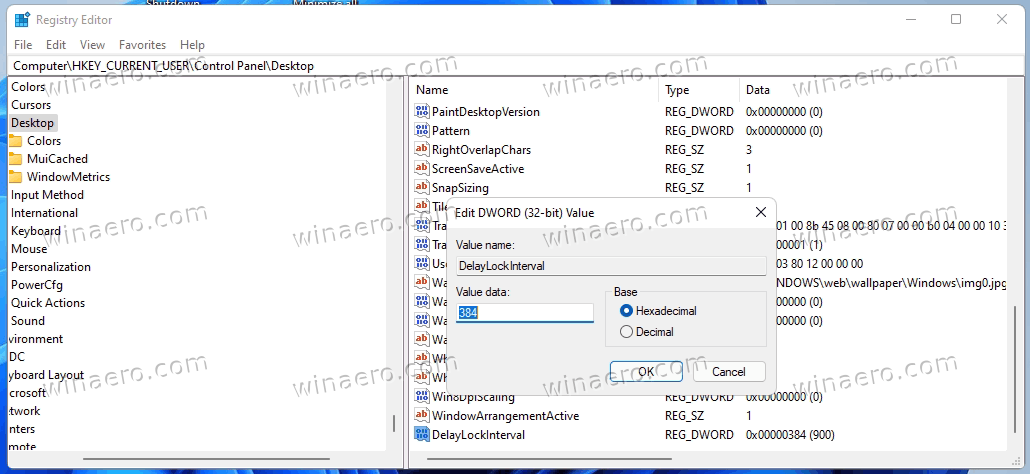
- Change its value to one of the following numbers:
- 0 = ask for password every time.
- 3c = ask the user to sign-in after 1 minute.
- b4 =Windows will ask for user's credentials in 3 minutes.
- 12c = ask for password in 5 mins.
- 384 = ask for password in 15 mins.
- ffffffff - never ask for password.
- You can now close the Registry Editor app.
The DelayLockInterval value corresponds the review Settings option on devices with Modern Standby. Again, you can save your time by using Registry files.
REG files
Download the ZIP archive using this link and extract the REG files to any folder location. The following files are included in the archive (with self-explanatory names).
- Never Ask for wake password with Modern Standby.reg
- Ask for wake password with Modern Standby Every Time.reg
- Ask for wake password with Modern Standby in 1 minute.reg
- Ask for wake password with Modern Standby in 3 minutes.reg
- Ask for wake password with Modern Standby in 5 minutes.reg
- Ask for wake password with Modern Standby in 15 minutes.reg
Finally, if the above is not enough, you can enforce the desired behavior with Group Policy. But keep in mind that this option has no effect with Modern Standby enabled. It only works with the classic Sleep and Hibernate options. As of the time of this writing, Windows 11 has less options to manage Modern Standby vs the classic power options. Modern Standby doesn't work like real standby mode, it is more like a screen-off mode with occasional low-power state but auto-wakeup features for certain devices.
Disable Wakeup Password in Group Policy
Note: The Local Group Policy Editor tool is available in the Windows 11 Pro, Enterprise, and Education editions. It is not available in Home editions of the OS, but you can use a tweak from the next chapter.
- Press Win + R, and type
gpedit.mscin the Run dialog to open Group Policy. - Expand open the left pane to
Computer Configuration\Administrative Templates\System\Power Management\Sleep Settings. - On the right, set the Require a password when a computer wakes (plugged in) to Disabled.
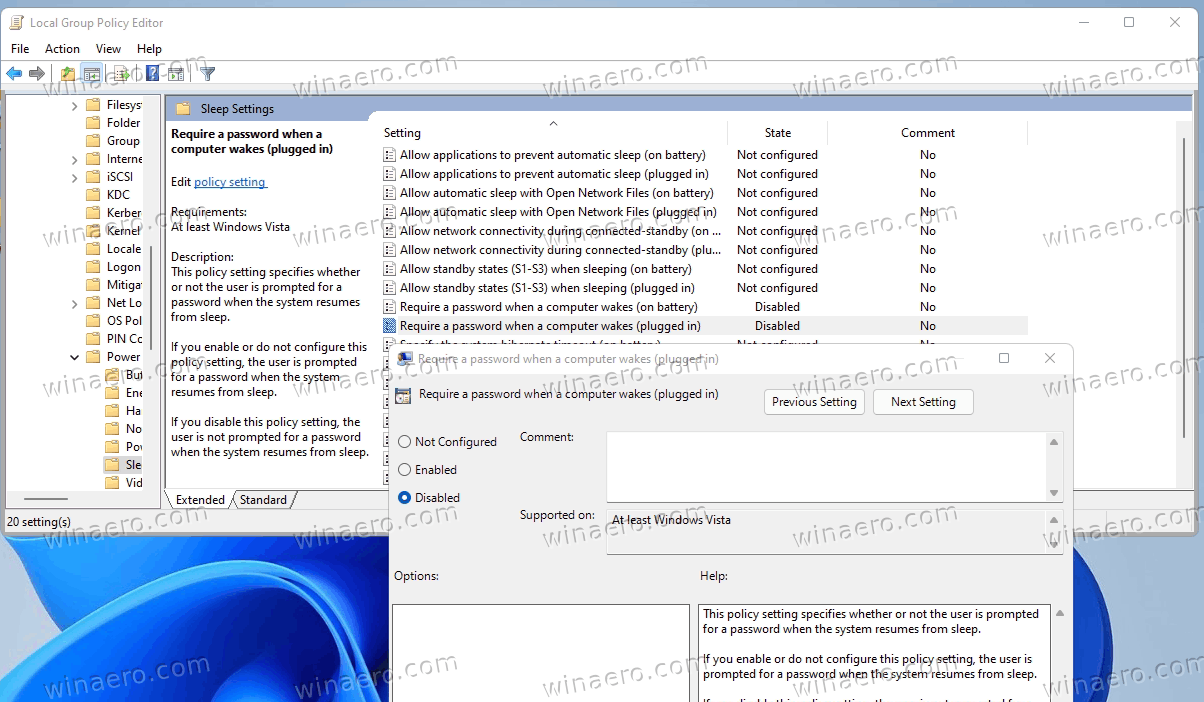
- Now, set the Require a password when a computer wakes (on battery) to Disabled too.
- Restart the computer to apply the policies to all user accounts in Windows 11.
You are done.
If you set the mentioned options to "Enabled", you will force-enable the Sign-in requirement on wake for all users. The corresponding value in the Settings app will be grayed out, and users won't be able to change it.
The default state of both options is "Not configured".
If your WIndows 11 edition doesn't include the gpedit.msc tool, you can apply the following Registry tweak.
Disable Sleep Password in Windows 11 Registry without Modern Standby
This method does work with Modern Standby. It is a corresponding Group Policy tweak for the Group Policies reviewed in the previous chapter.
To disable the Sleep Password in Windows 11, do the following.
- Open the Registry editor app (Win + R >
regedit). - Go to the following key:
HKEY_LOCAL_MACHINE\SOFTWARE\Policies\Microsoft\Power\PowerSettings\0e796bdb-100d-47d6-a2d5-f7d2daa51f51. Create this key if it is missing on your device. - Modify or create the
DCSettingIndex32-bit DWORD value on the right and set its value data to 0.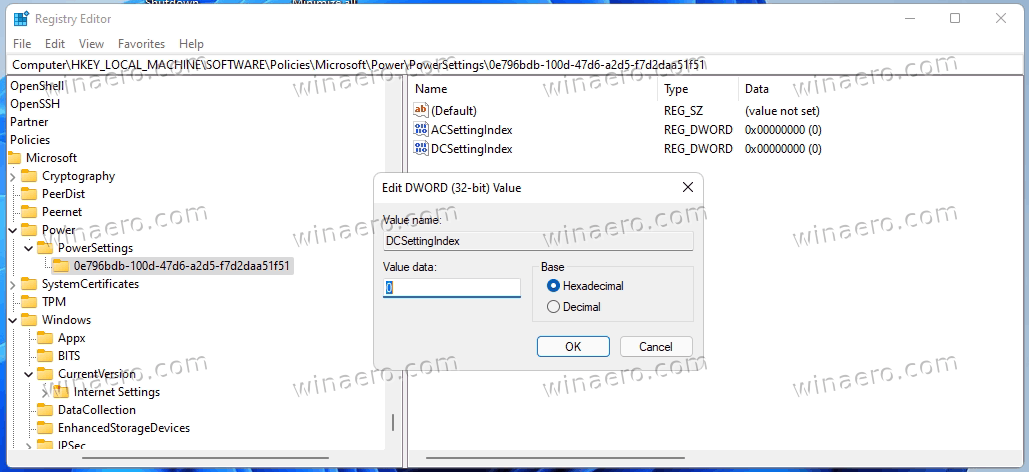
- Do the same for the
ACSettingIndexvalue.
That will disable the password on wake for all users.
Other values you can set are as follows.
- To enable the wake password, set both
ACSettingIndexandDCSettingIndexto 1. - To let the user to enable or disable the sign-in after Sleep, remove the values from the Registry.
Download Registry Files
To save your time, you can download the ready-to-use REG files from this link. Extract the archive you have downloaded. You will get three files.
-
Disable_wake_password.reg- Use this file to disable the wake password on Windows 11. -
Enable_wake_password.reg- re-enables the sign-in requirement. -
Defaults_for_wake_password.regallows Windows 11 users to configure the feature behavior in Settings.
That's it.
Support us
Winaero greatly relies on your support. You can help the site keep bringing you interesting and useful content and software by using these options:

Thanks, but none of these work for me
I still have to sign-in after sleep for both AC and DC after applying register and gpedit changes